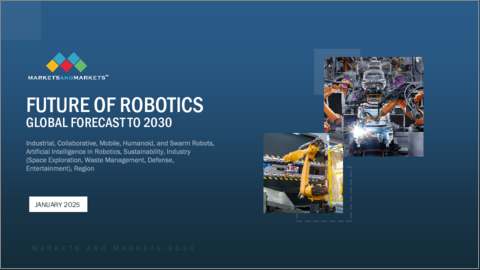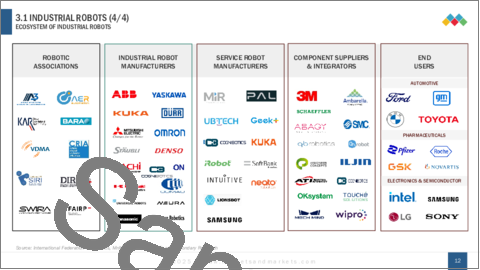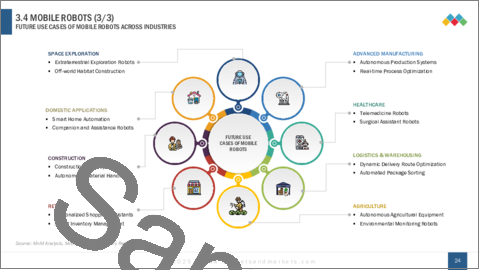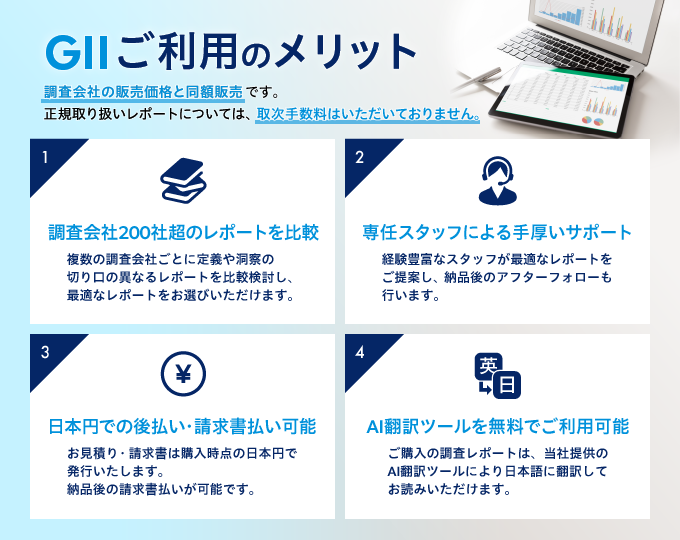|
|
市場調査レポート
商品コード
1648936
ロボティクスの世界市場の未来、コボット、ヒューマノイド・ソフトロボット、スワームロボティクス:技術別、産業別 - 予測(~2030年)Future of Robotics Market Cobots, Humanoid & Soft Robots, Swarm Robotics, by Technology, Industry - Global Forecast to 2030 |
||||||
カスタマイズ可能
|
|||||||
| ロボティクスの世界市場の未来、コボット、ヒューマノイド・ソフトロボット、スワームロボティクス:技術別、産業別 - 予測(~2030年) |
|
出版日: 2025年01月10日
発行: MarketsandMarkets
ページ情報: 英文 71 Pages
納期: 即納可能
|
全表示
- 概要
- 図表
- 目次
AIを搭載したロボットは、システムをより賢く、適応性を高め、自律的にすることで、ロボティクスの未来を変革しています。
これらのロボットは、リアルタイムのデータを処理し、環境を分析し、独自の意思決定を行うAIの能力を活用することで、産業全体の効率を大幅に向上させ、ミスを減らします。AIを活用したコンピュータービジョンは、ロボットが物体を識別し、動的な状況を理解し、精密な作業を行うことを可能にします。製造では、品質検査を実施し、コンポーネントを正確に組み立て、労働災害を最小化することで生産を合理化します。医療では、手術、患者のケア、日常業務においてAIロボットの恩恵を受け、安全性と業務効率が向上します。農業では、AIを搭載したロボットが作物の収穫、雑草管理、生産性を最適化し、手作業への依存を軽減します。輸送はAI駆動の自動運転車によって進歩し、モビリティに革命をもたらしています。一方、航空宇宙ではこれらのロボットが未知の地形をナビゲートし、宇宙飛行士を支援することで宇宙探査を支援しています。AIはまた、予知保全を強化し、ロボットが性能をモニターして問題を検出し、ダウンタイムを最小化することを可能にします。AI技術が進化するにつれて、それは産業全体のイノベーションを推進し、ロボットが複雑なタスクに取り組み、特定のニーズに適応し、よりインテリジェントで効率的な未来に向けオートメーションに革命を起こすことを可能にします。
「コボットの台頭が、よりスマートな未来に向けて人間と機械のギャップを埋めています。」
協働ロボット(コボット)は、人間と機械のシームレスな相互作用を可能にすることで、ロボティクスの未来を再構築しています。単独で動作する従来のロボットとは異なり、コボットは人間と一緒に安全に作業できるように設計されており、幅広い産業で生産性を高めています。反復的で危険な作業を代行することで、労働者はより複雑で価値をもたらす活動に集中することができます。近年のAI、機械学習、センサー技術の進歩により、コボットはより賢く、より適応性が高くなり、タスクを学習し、新しい環境に適応し、物理的な障壁なしに動作できるようになりました。その汎用性により、異なるタスクに対応するために簡単に再構成できるため、動的な生産環境に理想的です。衝突検知や力検知のような先進の安全機能を備えたコボットは、作業効率を高めながら、より安全な職場を作り出します。インダストリー4.0の主要コンポーネントとして、コボットは産業用IoT(IIoT)とシームレスに統合され、ワークフローを最適化し、データ駆動の意思決定を可能にします。労働力不足と効率化要求の高まりに対応することで、コボットはイノベーションを推進し、オートメーションにおける人間の役割を変革し、人間中心の共同作業への道を開きます。
「ソフトロボティクスは、オートメーションに柔軟で適応性の高い技術をもたらすことでイノベーションを推進しています。」
ソフトロボティクスは、ロボットが生物の自然な動きを模倣することを可能にする柔軟で柔らかい材料を活用することによって、オートメーションに変革をもたらそうとしています。この技術革新は、適応性の向上、より安全な人間とロボットの協働、費用対効果の高いソリューションなど、複数の重要な利点をもたらします。医療では、ソフトロボットが繊細な支援を提供し、最小のリスクで患者のケアを向上させることで、手術やリハビリテーションに革命をもたらしています。農業では、損傷を与えることなく作物を収穫するなど、より効率的で持続可能な作業を可能にしています。ソフトロボットは製造やロジスティクスにも波及しており、デリケートな商品を注意して扱う能力により、製品の損傷を減らし、生産性を向上させています。材料科学とAIの進歩が、よりスマートで高性能なシステムの開発を後押ししているため、ソフトロボットの可能性は拡大し続けています。研究者たちは、環境の持続可能性を確保しながら、性能を向上させる材料の創造に注力しています。これらの技術が進歩するにつれ、ソフトロボティクスは人間の能力を補完し、作業効率を向上させることで、世界中の産業に不可欠な存在となると見られます。安全性と柔軟性を重視することで、ソフトロボットは重要な技術革新を推進し、産業を再形成し、世界中の生活の質を向上させます。
当レポートでは、世界のロボティクス市場について調査分析し、自動化、ロボットインテリジェンス、コボットの進歩や、各産業へのロボティクスの統合を探りながら、ロボティクスの未来を考察しています。
目次
第1章 エグゼクティブサマリー
第2章 製造におけるロボティクスの進化
第3章 ロボティクス:タイプ別
- 産業用ロボット
- 協働ロボット(コボット)
- サービスロボット
- 移動ロボット
第4章 ロボティクスにおける技術の進歩
- ロボティクスにおけるAI
- ヒューマノイドロボット
- ソフトロボティクス
- スワームロボティクス
第5章 世界各地のロボティクスの見通し
- 北米
- 欧州
- アジア太平洋
- その他の地域
第6章 産業におけるロボットの未来
- 自動車
- 医療
- 電気・電子
- 宇宙探査
- 廃棄物管理
- 防衛
- エンターテインメント
第7章 持続可能性を形成するロボティクスの未来
第8章 ロボティクスにおける技術的課題
第9章 結論:2030年以降のロボティクスの未来
List of Tables
_
List of Figures
_
AI-powered robots are transforming the future of robotics by making systems smarter, more adaptive, and autonomous. These robots leverage AI's ability to process real-time data, analyze environments, and make independent decisions, significantly enhancing efficiency and reducing errors across industries. AI-driven computer vision enables robots to identify objects, understand dynamic conditions, and perform precision tasks. In manufacturing, they streamline production by conducting quality inspections, assembling components with accuracy, and minimizing workplace injuries. Healthcare benefits from AI robots in surgeries, patient care, and routine tasks, improving safety and operational efficiency. In agriculture, AI-powered robots optimize crop harvesting, weed control, and productivity, reducing reliance on manual labor. Transportation is advancing with AI-driven autonomous vehicles, revolutionizing mobility, while in aerospace, these robots support space exploration by navigating uncharted terrains and assisting astronauts. AI also enhances predictive maintenance, allowing robots to monitor performance, detect issues, and minimize downtime. As AI technology evolves, it will drive innovation across industries, enabling robots to tackle complex tasks, adapt to specific needs, and revolutionize automation for a more intelligent and efficient future.
"The rise of cobots is bridging the gap between humans and machines for a smarter future"
Collaborative robots, or cobots, are reshaping the future of robotics by enabling seamless interaction between humans and machines. Unlike traditional robots that operate in isolation, cobots are designed to work safely alongside humans, boosting productivity across a wide range of industries. By taking over repetitive and hazardous tasks, they free workers to focus on more complex and value-driven activities. Recent advancements in AI, machine learning, and sensor technologies have made cobots smarter and more adaptable, allowing them to learn tasks, adjust to new environments, and operate without physical barriers. Their versatility makes them ideal for dynamic production settings, as they can be easily reconfigured to handle different tasks. With advanced safety features like collision detection and force sensing, cobots create safer workplaces while enhancing operational efficiency. As key components of Industry 4.0, cobots integrate seamlessly with the Industrial Internet of Things (IIoT), optimizing workflows and enabling data-driven decisions. By addressing labor shortages and rising efficiency demands, cobots are driving innovation, transforming human roles in automation, and paving the way for collaborative, human-centric workplaces.
"Soft robotics is driving innovation by bringing flexible and adaptive technology to automation"
Soft robotics is transforming automation by utilizing flexible, soft materials that allow robots to mimic the natural movements of living organisms. This innovation offers several key advantages, such as enhanced adaptability, safer human-robot collaboration, and cost-effective solutions. In healthcare, soft robots are revolutionizing surgery and rehabilitation by providing delicate assistance and improving patient care with minimal risk. In agriculture, they are enabling more efficient and sustainable practices, like harvesting crops without causing damage. Soft robotics is also making waves in manufacturing and logistics, where their ability to handle delicate items with care is reducing product damage and increasing productivity. The potential of soft robots continues to grow as advances in material science and artificial intelligence drive the development of smarter, more capable systems. Researchers are focused on creating materials that improve performance while ensuring environmental sustainability. As these technologies progress, soft robotics will become an integral part of industries worldwide, complementing human abilities and enhancing operational efficiency. By emphasizing safety and flexibility, soft robots are set to drive significant innovation, reshaping industries and improving the quality of life globally.
"North America's role in robotics innovation and technological growth"
North America is leading the way in shaping the future of robotics, with significant developments in the US, Canada, and Mexico. According to the International Federation of Robotics (IFR), the US accounts for 77% of total robot installations, driven by substantial investments in automation, especially in the automotive and electronics sectors. Companies like Tesla and General Motors are investing heavily in robotics to boost production efficiency and address labor shortages. In Canada, the automotive sector has seen a remarkable 95% increase in robot installations, reflecting a growing commitment to automation. Government incentives for robotics research and development further support this trend, fostering innovation in sectors like healthcare and logistics. In addition, Mexico is adapting to shifting economic dynamics, with nearshoring efforts bringing supply chains closer to home. As these countries continue investing in robotics and embracing technologies like AI and machine learning, North America's robotics market is expected to grow significantly in the coming future, strengthening its position as a global leader in innovation.
Research Coverage:
This report examines the future of robotics, exploring the advancements in automation, robotic intelligence, collaborative robots (cobots), and the integration of robotics into various industries. It offers a forward-looking analysis of how robotics will evolve and shape industries by enhancing efficiency, reducing costs, and driving innovation in manufacturing, healthcare, logistics, and more.
Report Scope
This report provides an in-depth analysis of the trends that will transform robotics in the coming years. Key areas of focus include the integration of AI and machine learning with robotics, the rise of autonomous systems, soft robotics, swarm robotics, advancements in collaborative robotics, and the development of robots for new applications. Additionally, it covers the role of robotics in supporting sustainability efforts, improving productivity, and enabling new business models. These insights are invaluable for manufacturers, technology providers, investors, and policymakers looking to secure a competitive advantage while aligning their strategies with the future evolution of robotics.
TABLE OF CONTENTS
1 EXECUTIVE SUMMARY
2. EVOLUTION OF ROBOTICS IN MANUFACTURING
3. ROBOTICS BY TYPE
- 3.1 INDUSTRIAL ROBOTS
- 3.2 COLLABORATIVE ROBOTS (COBOTS)
- 3.3 SERVICE ROBOTS
- 3.4 MOBILE ROBOTS
4. TECHNOLOGICAL ADVANCEMENTS IN ROBOTICS
- 4.1 AI IN ROBOTICS
- 4.2 HUMANOID ROBOTS
- 4.3 SOFT ROBOTICS
- 4.4 SWARM ROBOTICS
5. GLOBAL REGIONAL OUTLOOK ON ROBOTICS
- 5.1 NORTH AMERICA
- 5.2 EUROPE
- 5.3 ASIA PACIFIC
- 5.4 ROW
6. FUTURE OF ROBOTICS IN INDUSTRIES
- 6.1 AUTOMOTIVE
- 6.2 HEALTHCARE
- 6.3 ELECTRICAL & ELECTRONICS
- 6.4 SPACE EXPLORATION
- 6.5 WASTE MANAGEMENT
- 6.6 DEFENSE
- 6.7 ENTERTAINMENT





